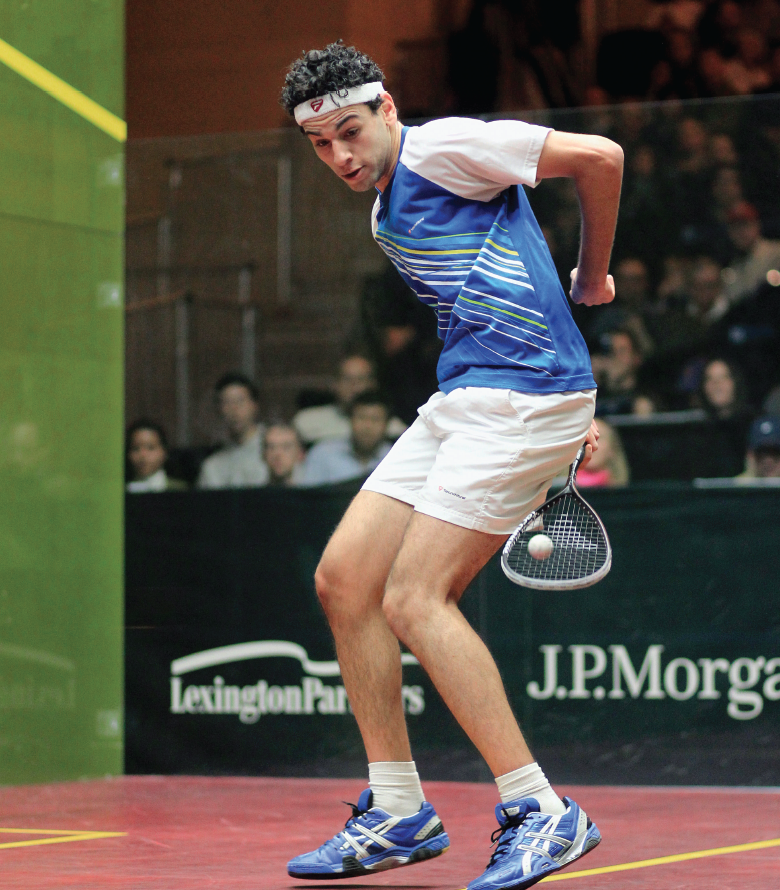By Barry Faguy, WSF Referees and Rules Committee
“Ask me no questions, and I’ll tell you no lies.” Hmmm! I’ll make an exception for the next few editions that will feature questions that have piled up over time. No doubt, one or more of these were on your mind!
HEY REF! What happens if the striker hits the opponent with the ball going directly to the front wall—but it was struck from behind the back or between the legs?
A long time ago before electricity (pre-1989), these actions were considered as ‘turning’, and a Let was always played. Nowadays, we have electricity and things have changed—so no special significance is given to those types of returns. In the case cited, it would be Stroke to the striker, plain and simple.
HEY REF! When is it official that a ball has broken— and what happens if my opponent wants to change the ball (that is obviously not broken) and I don’t?
Unfortunately, there is no definition for ‘broken ball’, but it’s generally taken to mean a loss of pressure. A split in the seam doesn’t count since a ball can keep going for a long time in that condition. As for the 2nd part of the question, the rules state that the Referee “may” change an unbroken ball by mutual consent of the players, or on appeal by one player. Typical reasons that some players give are that the ball is either too-bouncy, or too-slow—or simply “cuz it don’t feel right!” If the opponent doesn’t want a change, a Referee is then placed between a rock and a hard place.

HEY REF! What happens if the striker postures with the racquet as if to be hitting a drop shot— but lets the ball go by, and it then hits the non-striker who is standing immediately behind, but clear of the swing?
This can be tricky stuff. If there was no forward motion of the striker’s racquet, then this is not considered an attempt—and so the striker gets a Stroke. If there was forward motion, then this would fall under the ‘further attempts’ provisions and could be a Let. Now here’s a neat twist; suppose there was no forward motion, but now the opponent, having lost the rally, complains that the striker was actually stopping play and asking for a Let (say for fear of injury). If the Referee asks and the striker confirms it—then the Stroke decision would need to be reversed to ‘Yes, Let’ because play would be deemed to have stopped at the moment of the appeal. If the striker answers “No”, then the Stroke decision stands, simply because there was no appeal. We then have the original case where the ball has simply hit the non-striker.
HEY REF! Is it OK for the ref to ask a question of the players to clarify an interference situation—or should the decision be made simply on what was seen?
Many people say it’s a no-no to ask players about an unclear situation—but if you think about it, it would be unfair to make a decision without certain information. (In fact, the next edition of the rules will oblige it—in contrast to the current rules where it’s an option.) The most typical situation is ‘unseen racquet contact’ on the back-swing. Usually, the ball has gone ‘down’ and the striker immediately turns around and asks for a Let. Often, the Referee had not seen any contact and says ‘No Let’. The player then immediately explains about the racquet contact—and so now the Referee needs to ask the opponent. If confirmed, the decision will surely change. Occasionally, the opponent will deny the contact, or even refuse to answer—leaving the Referee with the initial decision—or opting to claim ‘uncertainty’ and so play a Let.
HEY REF! What happens if my opponent is wearing a shirt stamped with foul language, or a hat, or something like that that bothers me. Can he or she be made to get rid of it?
Absolutely! The Referee is charged with weighing in on such matters that can be “disruptive, intimidating or offensive to the opponent, an official or a spectator, or could in any way bring the game into disrepute” — and so oblige the opponent to change. The Referee can require this change even if there is no complaint— keeping in mind the best interests of the sport. A delicate hand is often necessary so as to not set off a powder keg between two players.
HEY REF! What happens if, right in the middle of a rally, my opponent suddenly raises a hand meant to cast doubt on one of my returns? That really bugs me. Can I stop play and claim that as a legitimate distraction?
That happens often. Most Referees will indeed grant you a Let for that because it’s an action out of the ordinary—and generally obvious if it caused a genuine distraction. However, sometimes it’s clear to the Referee that the ‘appealer’ is simply looking for a way to get out of a bad spot. The key here for the Referee is not so much to decide on the nature of the action itself— but to determine the effect that it had on the player claiming distraction. Finally, the other issue that needs consideration here is whether the distraction was ‘accidental’ (no intent to distract), or deliberate. Any deliberate distraction would of course, require application of a Conduct penalty.


